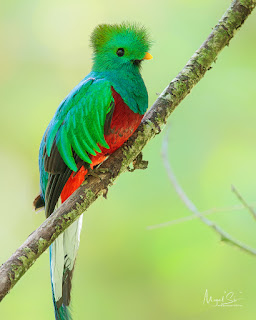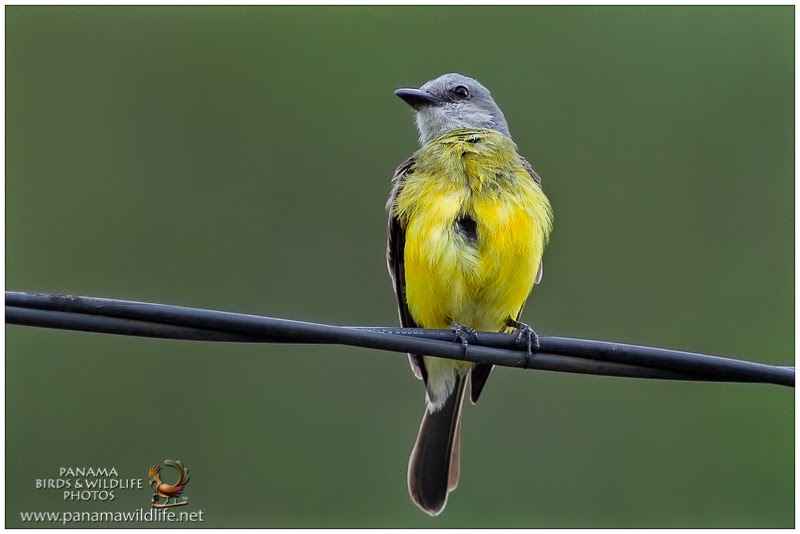 |
| Bicolored Antbird (Gymnopithys bicolor) |
Eciton is a New World
army ant genus that contains the most familiar species of army ants, being the most predominant and well-known species is
Eciton burchellii, which is also more commonly known as the army ant. They are very visible because they forage above ground and during the day, in enormous raiding swarms. During a tour around Pipeline Road, we found one of these swarms and entered into it to grab pictures of several birds that were feeding at the swarm, obviously being very carefully of not stepping on the ants; not only to avoid harming them but also for our own safety. These ants are ravaging and their bite can be harmful to humans.
 |
| Gray-headed Tanager (Eucometis penicillata) |
Eciton army ants have a bi-phasic lifestyle in which they alternate between a nomadic phase and a
statary phase. In the statary phase, which lasts about three weeks, the ants remain in the same location every night. They arrange their own living bodies into a nest, protecting the queen and her eggs in the middle. When the eggs hatch, the excitement caused by the increased activity of the larvae causes the colony to enter the nomadic phase. In the nomadic phase the ants move their entire colony to a new location nearly every night for about two weeks, around the time when the larvae begin to
pupate, the colony again enters the statary phase, and the cycle begins anew.
 |
| Whooping Motmot (Momotus subrufescens) |
Because of the regularity and intensity of army-ants swarms, many insect and
bird species have evolved complex relationships with these ants. While foraging, army ants cause many invertebrates to flee from their hiding places under leaves of the forest floor, under tree bark, and other such locations, thereby allowing predators to catch them more easily. For example, in the tropical rainforests of Panama, swarms of army ants attract many species of birds to this feast of scrambling insects, spiders, scorpions, worms, and other animals. Some of these birds are named
“antbirds” due to this tendency. While focused on feeding on these invertebrates,
birds at army-ant swarms typically allow very close approach by people—within 1 or 2 meters in many cases—often providing the best opportunities to see and photograph many of these species. Depending on the size of the ant swarm and the amount of prey the ants stir up, birds can number from a few to dozens of individuals. Birds that frequent army-ant swarms include the white-whiskered puffbird, rufous motmot,
whopping motmot, rufous-vented ground cuckoo, gray-necked wood rail,
plain-brown woodcreeper,
northern barred woodcreeper, cocoa woodcreeper, black-striped woodcreeper, fasciated antshrike, black-crowned antshrike,
spotted antbird,
bicolored antbird, ocellated antbird, chestnut-backed antbird, black-faced antthrush, and
gray-headed tanager. Some of which are pictured on this post.
 |
| Bicolored Antbird (Gymnopithys bicolor) |
 |
| Bicolored Antbird (Gymnopithys bicolor) |
 |
| Bicolored Antbird (Gymnopithys bicolor) |
 |
| Bicolored Antbird (Gymnopithys bicolor) |
 |
| Northern Barred Woodcreeper (Dendrocolaptes sanctithomae) |
 |
| Northern Barred Woodcreeper (Dendrocolaptes sanctithomae) |
 |
| Northern Barred Woodcreeper (Dendrocolaptes sanctithomae) |
 |
| Northern Barred Woodcreeper (Dendrocolaptes sanctithomae) |
 |
| Northern Barred Woodcreeper (Dendrocolaptes sanctithomae) |
 |
| Northern Barred Woodcreeper (Dendrocolaptes sanctithomae) |
 |
| Northern Barred Woodcreeper (Dendrocolaptes sanctithomae) |
 |
| Plain-brown Woodcreeper (Dendrocincla fuliginosa) |
 |
| Plain-brown Woodcreeper (Dendrocincla fuliginosa) |
 |
| Spotted Antbird (Hylophylax naevioides) - male |
 |
| Spotted Antbird (Hylophylax naevioides) - female |
 |
| Spotted Antbird (Hylophylax naevioides) - female |
 |
| Spotted Antbird (Hylophylax naevioides) - female |
 |
| Spotted Antbird (Hylophylax naevioides) - male |
























I am very glad to here. Thanks for sharing this wonderful article. Please check my blog website. And revert back with few suggestions please.
ReplyDeleteTheFreeGuy!
M2M Sim Card is on the increase, and with them come new opportunities. We've never previously seen the potential for devices to share information, work together, and even have conversations with one another. This technology is allowing for immediate judgements to be made, which is increasing productivity and decreasing the need for human involvement. In a nutshell, the future seems intelligent and linked.
ReplyDeleteSatılık Tiny House arsaları, genellikle doğanın içinde, ormanlık alanlara yakın veya göl kenarında gibi doğal güzelliklere sahip bölgelerde bulunur. Bu arsalar, sakin bir yaşam tarzını arzulayanlar ve şehir karmaşasından uzaklaşmak isteyenler için idealdir. Doğa ile iç içe bir yaşamın kapılarını aralayan bu arsalar, enerji verimliliği ve çevresel sürdürülebilirlik konusunda da avantajlar sunar.
ReplyDeleteTiny House Arsa Seçerken Nelere Dikkat Edilmeli?
İmar Durumu: Tiny House projesi için seçeceğiniz arsanın imar durumu önemlidir. İnşaat izinleri ve kullanım alanları, projenizi etkileyen faktörlerdir.
Altyapı ve Ulaşım: Seçtiğiniz arsanın altyapısı ve ulaşım imkanları, günlük yaşamınızı etkiler. Elektrik, su, kanalizasyon gibi temel altyapı unsurlarının yanı sıra, ulaşım kolaylığı da göz önünde bulundurulmalıdır.
Çevresel Faktörler: Arsanın çevresi, yaşam kalitenizi belirleyen unsurlardan biridir. Doğa manzarası, komşuluk ilişkileri ve çevresel faktörler, Tiny House yaşamınızı olumlu yönde etkiler.
Planlı Gelişim: Arsanın bulunduğu bölgedeki planlı gelişimler, değer artış potansiyelini etkiler. Bölgenin gelecekteki projeleri ve planları, yatırımınızın değerini artırabilir.
Hayalinizdeki evi bulmak ve sıcak bir yaşam başlatmak için hazır mısınız? Şimdi, sakinliğiyle ünlü Urla'da, hayallerinizi gerçeğe dönüştürecek bir urlada satılık villa fırsatı sizi bekliyor!
ReplyDeleteModa dünyasının vazgeçilmez parçalarından biri olan bralet, son yıllarda birçok kadının gardırobunda önemli bir yer edinmiştir. Bu şık ve rahat parça, hem günlük kullanım hem de özel günlerde kombinlerin vazgeçilmez bir tamamlayıcısı olabilir. Ancak, bir bralet seçerken doğru bedeni bulmak ve stilinize uygun bir şekilde giymek önemlidir.
ReplyDeleteDans le cadre de la construction ou de la rénovation d’une habitation, la plomberie fait partie des travaux de second œuvre les plus complexes. En effet, les conséquences des défauts d’installation sont particulièrement pénibles : fuite d’eau, dégât des eaux, canalisation bouchée, manque de pression. Le moindre dysfonctionnement engendre des travaux de réparations longs et coûteux.
ReplyDeleteÇiçekler, duygularımızı ifade etmenin en güzel yollarından biridir. Bir sevdikimize duyduğumuz sevgiyi, bir arkadaşımıza duyduğumuz minneti ya da bir tebriği ifade etmek için çiçeklerin benzersiz gücünden yararlanabiliriz. Çiçek Sepeti, bu anlamlı ifadeleri yaşamımıza taşıyan bir online çiçek dükkanı olarak öne çıkıyor.
ReplyDeleteÇiçek Sepeti, geniş ürün yelpazesiyle her türlü özel gün ve durum için mükemmel çiçekleri sunuyor. Doğum günleri, anneler günü, sevgililer günü veya sadece sevdiklerimize sürpriz yapmak için ideal çiçek seçeneklerini bulabilirsiniz. Sitede gezinirken, her bir çiçek aranjmanının özenle seçilmiş olduğunu ve en taze çiçeklerle hazırlandığını göreceksiniz.
Günümüzde, insanlar giderek daha fazla sürdürülebilir ve minimal bir yaşam tarzını tercih ediyorlar. Bu eğilim, geleneksel konut modellerine alternatif arayışları da beraberinde getiriyor. "Tiny House" olarak bilinen küçük evler ve "Yaşam Bahçeleri", doğaya uyumlu bir yaşam biçimini teşvik eden önemli unsurlardır. Ancak bu unsurlar, uygun bir arazi parçası olmadan tam potansiyellerine ulaşamazlar. İşte Tiny House arsaları ve yaşam bahçelerinin bir araya gelmesinin gücüne dair bir bakış.
ReplyDeleteWe’re in the business of improvement. In addition to giving you the best tummy tuck, we always perform safe BBLs because we only perform ultrasound-assisted BBLs. Add 360 liposuction to complete the package. Your happiness is our happiness and your safety is our priority.
ReplyDeleteWitdry
ReplyDeleteBaşakşehir evden eve nakliyat
ReplyDeleteİşletmenizin dijital dünyada daha güçlü bir varlık göstermesi için ihtiyaç duyduğunuz tüm hizmetleri sunan profesyonel bir dijital medya ajansıyız. Web tasarımından sosyal medya yönetimine, Google Ads kampanyalarından video prodüksiyonuna kadar geniş bir hizmet yelpazesi ile markanızı bir adım öne taşımaya hazırız. Deneyimli ekibimizle, hedeflerinizi gerçekleştirmek ve çevrimiçi varlığınızı büyütmek için buradayız. Bize ulaşarak dijital stratejinizi güçlendirin ve işinizi bir sonraki seviyeye taşıyın.
ReplyDeleteCRM yazılımımız, işletmenizin müşteri ilişkilerini daha etkin yönetmesine yardımcı olan, kapsamlı ve kullanıcı dostu bir çözümdür. Bu yazılım, müşteri verilerini tek bir platformda toplar, satış süreçlerini optimize eder ve müşteri memnuniyetini artırmak için analizler sunar. İş akışlarını kolaylaştırarak zamandan tasarruf sağlar, ekibinizin performansını yükseltir ve müşteri sadakatini güçlendirir. Firmaya özel CRM çözümlerimizle, iş ihtiyaçlarınıza uygun özelleştirmeler yaparak verimliliğinizi en üst düzeye çıkarıyoruz. Dijital dönüşümde bir adım önde olmak için CRM yazılımımızı tercih edin!
ReplyDeletefirma sitesi örnekleri
ReplyDeleteanahtar teslim web sitesi görüntüle
ReplyDeleteKurumsal web sitesi ve örnekleri
ReplyDeletefirma sitesi
ReplyDeleteDijital Dünyanın Süper Kahramanı: Hakan Gör
ReplyDeleteDijital medyanın sonsuz evreninde, kahramanlar genelde kodlarla, tasarımlarla ve yaratıcı fikirlerle savaşır. Ve işte burada devreye Hakan Gör giriyor! O, klavyesini kılıç gibi kullanan, sosyal medya yönetimini bir sanat dalına çeviren ve dijital pazarlamada rakiplerine "404" hatası veren bir uzman.
Web Tasarımının Michelangelo'su
Hakan Gör, web tasarımı denince akla gelen ilk isimlerden biri. Sıradan bir web sitesini, kullanıcıların tıklamaya doyamayacağı bir şahesere dönüştürme yeteneğiyle tanınıyor. Bir web sitesini hem estetik hem de işlevsel yapabilmek, onun uzmanlık alanı. Ayrıca söylentilere göre, bir HTML kodu bile Hakan’ın ellerinde adeta dans ediyor!